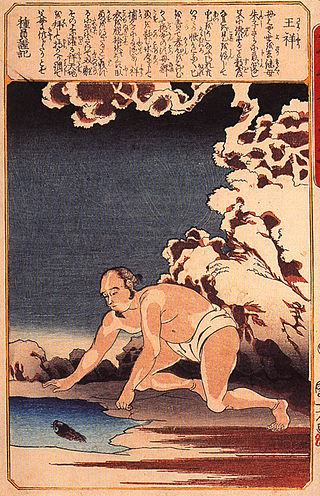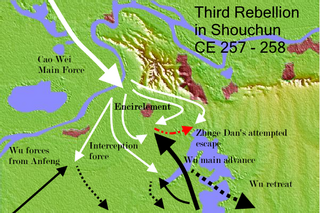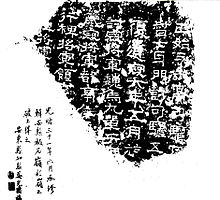
Wei (220–266), known as Cao Wei (曹魏) or Former Wei in historiography, was a dynastic state of China and one of the three major states that competed for supremacy over China in the Three Kingdoms period. With its capital initially located at Xuchang, and thereafter Luoyang, the state was established by Cao Pi in 220, based upon the foundations laid by his father, Cao Cao, towards the end of the Eastern Han dynasty.
Gongsun Yuan, courtesy name Wenyi, was a Chinese military general, politician, and warlord who lived in the state of Cao Wei during the Three Kingdoms period of China. He rebelled against Wei in 237 and declared himself "King of Yan" (燕王). In 238, the Cao Wei general Sima Yi led forces to Liaodong and successfully conquered Yan.
Cao Rui, courtesy name Yuanzhong, was the second emperor of the state of Cao Wei during the Three Kingdoms period. His parentage is in dispute: his mother, Lady Zhen, was Yuan Xi's wife, but she later remarried Cao Pi, the first ruler of Wei. Based on conflicting accounts of his age, Pei Songzhi calculated that, in order to be Cao Pi's son, Cao Rui could not have been 33 when he died as recorded, so the recorded age was in error; late-Qing scholar Lu Bi and Mou Guangsheng argued instead that Cao Rui was Yuan Xi's son.
Cao Mao, courtesy name Yanshi, was the fourth emperor of the state of Cao Wei during the Three Kingdoms period of China. He was a grandson of Cao Pi, the first emperor of Wei. Described as intelligent and studious, Cao Mao made repeated attempts to seize back state power from the regent Sima Zhao but failed. He was killed in an abortive coup d'état against Sima Zhao.

Sima Shi, courtesy name Ziyuan, was a military general and regent of Cao Wei during the Three Kingdoms period of China. In 249, he assisted his father Sima Yi in overthrowing the emperor Cao Fang's regent Cao Shuang, allowing the Sima family to become paramount authority in the state, and he inherited his father's authority after his father's death in 251. He maintained a tight grip on the political scene and, when the emperor, Cao Fang, considered action against him in 254, had him deposed and replaced with his cousin, Cao Mao. This tight grip eventually allowed him to, at the time of his death in 255 after just having quelled a rebellion, transition his power to his younger brother, Sima Zhao, whose son Sima Yan eventually usurped the throne and established the Jin dynasty.

Zhuge Dan, courtesy name Gongxiu, was a Chinese military general and politician of the state of Cao Wei during the Three Kingdoms period of China. When he held key military appointments throughout his middle to late career, he was involved in all of the three rebellions which broke out in Shouchun between 251 and 258. During the second rebellion, he actively assisted the Wei regent Sima Shi in suppressing the revolt. After the rebellion, the Wei government put him in charge of Shouchun. As the Sima clan became more powerful and established themselves as the de facto rulers of Wei, Zhuge Dan feared that he would end up slain like Wang Ling and Guanqiu Jian – the leaders of the first two rebellions – so he started the third rebellion against Sima Zhao, who succeeded Sima Shi as regent of Wei in 255. Although he received some support from Wei's rival state Eastern Wu, his rebellion was eventually suppressed by Wei imperial forces and he met his end at the hands of Hu Fen, a military officer under Sima Zhao.
Empress Guo, personal name unknown, formally known as Empress Mingyuan, was an empress of the state of Cao Wei during the Three Kingdoms period of China. She was married to Cao Rui, the second ruler of Wei; she was his third wife and second empress. The limited information available about her appears to portray her as an intelligent woman who fought hard to prevent her empire from falling into the hands of the Sima clan during the reigns of her adopted son Cao Fang and his cousin Cao Mao, but was unable to stem the tide.
Sun Liang, courtesy name Ziming, was the second emperor of the state of Eastern Wu during the Three Kingdoms period of China. He was the youngest son and heir of Sun Quan, the founding emperor of Wu. He is also known as the Prince of Kuaiji or Marquis of Houguan (候官侯), which were his successive titles after he was deposed in November 258 by the regent Sun Chen. He was succeeded by his brother Sun Xiu, who managed to oust Sun Chen from power and kill him. Two years after Sun Liang's dethronement, he was falsely accused of treason and demoted from a prince to a marquis, after which he committed suicide.
Wang Su (195–256), courtesy name Ziyong, was an official and Confucian scholar of the state of Cao Wei during the Three Kingdoms period of China. He was a son of Wang Lang. When Guanqiu Jian started a rebellion in Shouchun, Wang Su advised Sima Shi to lower the rebels' morale by treating their families with respect. Following that, Wang Su entreated Cao Mao to allow Sima Zhao to succeed Sima Shi as regent of Wei.

Wang Chang, courtesy name Wenshu (文舒), was a Chinese military general and politician of the state of Cao Wei during the Three Kingdoms period of China.
Wen Qin, courtesy name Zhongruo, was a Chinese military general and politician of the state of Cao Wei during the Three Kingdoms period of China.

Wang Xiang, courtesy name Xiuzheng, was a Chinese politician who lived through the late Eastern Han dynasty (25–220), the Three Kingdoms period (220–280), and the early Western Jin dynasty (266–316) of China. He served in the highest positions in the government, including Minister of Works (司空) and Grand Commandant (太尉) in the Cao Wei state during the Three Kingdoms period, and Grand Protector (太保) during the Western Jin dynasty. He was also one of The Twenty-four Filial Exemplars.
Fu Gu (209–255), courtesy name Lanshi, was an official of the state of Cao Wei during the Three Kingdoms period of China.

Wang Ji, courtesy name Boyu, was a military general of the state of Cao Wei during the Three Kingdoms period of China. He started his career as a low-ranking official under Wang Ling, the governor of Qing Province. During this time, he was noted for exemplary performance and was later transferred to the central government in Luoyang. He was subsequently promoted to the position of a commandery administrator, but was briefly removed from office when the Wei regent Sima Yi ousted his co-regent Cao Shuang in a coup d'état in 249. However, he was quickly recalled to government service, promoted to the position of governor of Jing Province and appointed as a military general. From 251 until his death in 261, Wang Ji maintained close but professional working relationships with the Wei regents Sima Shi and Sima Zhao. During this time, he supervised military operations in Jing, Yu and Yang provinces, and defended Wei's eastern and southern borders against attacks by Wei's rival state, Eastern Wu. He also assisted Sima Shi and Sima Zhao in suppressing two of the three Shouchun rebellions in 255 and 257–258 respectively. In 261, in the months just before his death, he correctly pointed out that two Eastern Wu military officers were pretending to defect to Wei, and managed to stop the Wei forces from falling into a trap.
The Goguryeo–Wei War was a series of invasions of Goguryeo from 244 to 245 launched by Cao Wei.
The Three Rebellions in Shouchun were a series of revolts that occurred in the state of Cao Wei during the Three Kingdoms period. The rebellions broke out in the later years of Wei when the Sima clan, headed by Sima Yi, usurped state power. The military governors of Shouchun rose in revolt thrice in the name of a rebellion to oust the Sima clan from power. The respective leaders of the three rebellions were Wang Ling, Guanqiu Jian and Wen Qin, and Zhuge Dan. All the revolts were eventually suppressed.

Zhuge Dan's Rebellion, or the Third Rebellion in Shouchun, was a revolt led by Zhuge Dan, a general from the state of Cao Wei, against the regent Sima Zhao. Zhuge Dan received some support from Eastern Wu, Cao Wei's rival state. It was the third and final of a series of three rebellions that took place in Shouchun in the 250s during the Three Kingdoms period of China.
Sima Yi's Liaodong campaign occurred in 238 CE during the Three Kingdoms period of Chinese history. Sima Yi, a general of the state of Cao Wei, led a force of 40,000 troops to attack the kingdom of Yan led by warlord Gongsun Yuan, whose clan had ruled independently from the central government for three generations in the northeastern territory of Liaodong. After a siege that lasted three months, Gongsun Yuan's headquarters fell to Sima Yi with assistance from Goguryeo, and many who served the Yan Kingdom were massacred. In addition to eliminating Wei's rival in the northeast, the acquisition of Liaodong as a result of the successful campaign allowed Wei contact with the non-Han peoples of Manchuria, the Korean Peninsula, and the Japanese archipelago. On the other hand, the war and the subsequent centralisation policies lessened the Chinese grip on the territory, which permitted a number of non-Han states to form in the area in later centuries.

Guanqiu Jian and Wen Qin's Rebellion, or the Second Rebellion in Shouchun, was a punitive uprising led by Guanqiu Jian and Wen Qin, two generals from the state of Cao Wei, against the regent Sima Shi and his clan. This was the second of a series of three rebellions that all took place in Shouchun in the 250s during the Three Kingdoms period in Chinese history.
The Battle of Dongxing, also known as the Battle of Dongguan, was fought from January to February 253 between the states of Cao Wei and Eastern Wu during the Three Kingdoms period of China. The battle concluded with a tactical victory for Wu.








